
The nature of business as we know it is changing. In the past, employers and employees had to work in the same location, often commuting to the same office or headquarters.
Although many industries and occupations still require location-specific work, the rise of new technologies has enabled companies to recruit and collaborate with qualified talents outside of their city or, sometimes, even beyond their nation’s borders.
A recent study has found that today’s top executives remain in the most expensive cities in the U.S., while customer service workers live in more affordable areas. This practice is one of the emerging trends under what is now called “domestic offshoring.” It is one of the different outsourcing models businesses use to fortify their operations and make them more flexible and agile.
Modern Problems Require Modern Solutions
Domestic offshoring is a solution focused on customer service and tech roles, helping to fill the gaps in the scarce talent supply for these jobs and address the continually changing post-pandemic work environment.
On the other hand, other outsourcing models, such as onshoring, offshoring, and nearshoring, can cover a wide range of roles beyond customer service, including recruitment, back-office support, and even specialized functions like software development.
The common denominator between all these different solutions is that businesses can implement them into their operations with the help of a reliable outsourcing partner.
Let’s take a closer look at each of these strategic models and discuss how they can benefit companies in today’s day and age.
A Comparative Look at Different Outsourcing Models
Domestic Offshoring
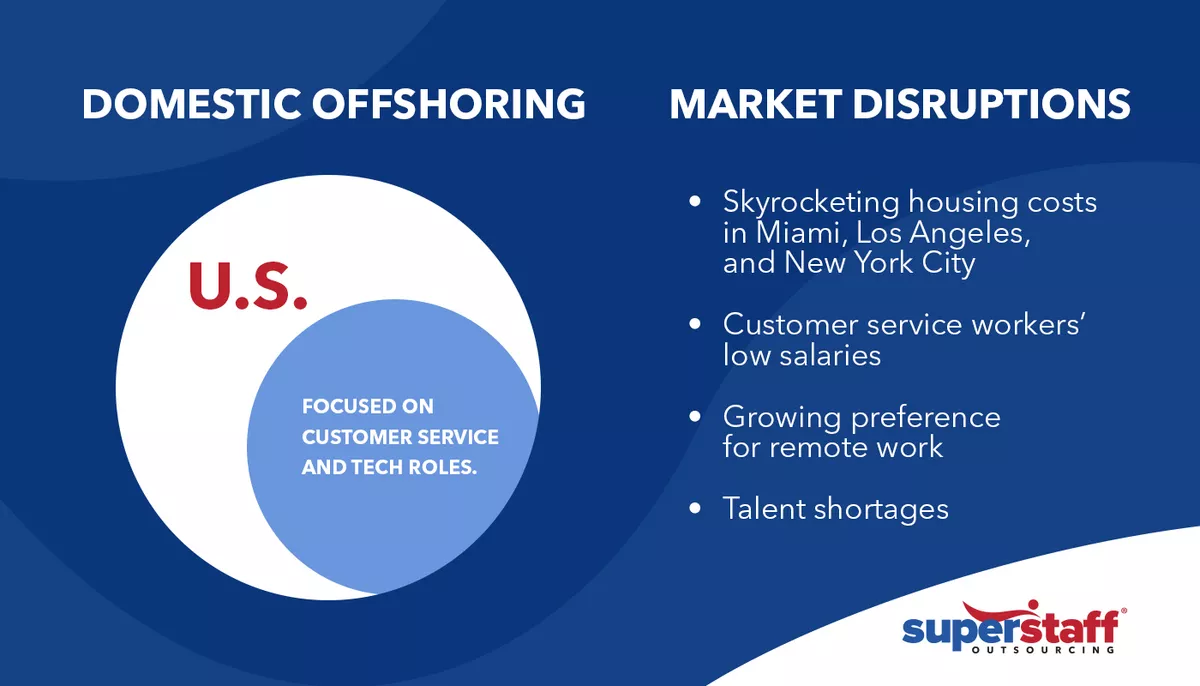
Historically, only a few key U.S. cities held all the economic and political power. Employees searching for high-paying roles often had to relocate to the country’s leading business hubs like New York City and Washington, D.C.
However, steadily increasing cost of living and housing prices prevent many workers from staying and working in these key cities. Thankfully, new technologies have created opportunities that may benefit both employees and employers in this regard.
The rise of telecommuting during the COVID-19 pandemic shifted our national workplace culture. Instead of forcing employees to relocate, more businesses began to embrace domestic offshoring, which allowed them to hire and retain workers from all over the country.
At the same time, workers were allowed to live and stay in more affordable areas while still being employed by companies headquartered in more congested and expensive cities.
The C-Suite-Customer Service Worker Ratio
A recent ADP Research Institute survey found that many customer service workers have jobs that don’t pay enough to cover housing costs in places like New York or San Francisco. As such, many of these low-wage employees have been moving to more affordable cities like Phoenix or Orlando.
The same study analyzed the ratio of C-suites to customer service workers in these key cities. Senior executives, policymakers, and other business leaders are over-represented in the expensive cities, while customer support agents are scattered to the more affordable areas.
Take a look at these eye-opening data and numbers:
- The average customer service representative earned a median of $45,130, while the average C-suite earned $201,622.
- The national median cost of homes is $355,852, but for more expensive cities like New York, the median price can reach up to $776,946.
- Of the 56 metros with more than a million residents, 25 scored above the national ratio of 100, meaning that these cities had more top executives per customer service worker.
- For example, San Francisco Bay has a location quotient of 140, indicating that executives are 40% more prevalent than in other cities.
- Examples of cities scoring above the national average in terms of C-suites include Los Angeles, New York, Washington, Miami, and San Francisco, historically the areas with the most political and economic power.
- Cities with the sharpest rise in housing costs (such as Austin, Denver, and Seattle) also had the most significant increases in the number of executives living there.
What Are the Factors Shaping Domestic Offshoring?
Rising Housing Costs
As mentioned above, continually increasing housing costs are among the top reasons for the rise in domestic offshoring.
According to the Chamber of Commerce, more than 1 in 4 Americans are now considered “house poor,” meaning they spend more than 30% of their income on housing costs. These homeowners struggle to keep up with rising interest rates, monthly mortgage payments, utility bills, and property taxes.
In 2022, mortgage interest rates climbed past 7%, making it the highest rate in over 20 years. Add skyrocketing inflation, steadily increasing cost of living, and stagnating wages to the mix, and you’ll quickly understand why so many homeowners are dealing with empty bank accounts.
Unsurprisingly, the top three cities with the highest number of “house poor” Americans (Miami, Los Angeles, and New York City) are among the places with the highest ratio of executives per customer service employee. Except for New York City, all the expensive cities are also in California or Florida.
For this reason, customer service representatives and other employees have taken advantage of the opportunity to work remotely. They are relocating to cities with less expensive housing costs, including Illinois, Ohio, Oklahoma, and Michigan.
Preference for Remote Work
Another factor shaping the rise of domestic offshoring is employees’ growing preference for remote work. In the past, remote work was a rarity, but the pandemic accelerated the need for business location flexibility.
Now, even post-COVID, most employees prefer working from home. According to a 2023 survey, 91% of respondents enjoy remote work and consider flexibility the most significant benefit their employer offers.
A different study echoed these findings, highlighting that 87% of job seekers would jump at the chance to work remotely when offered.
However, economists noted that the growing preference for remote work also contributes to the rise in housing costs. The U.S. Bureau of Labor Statistics shared that areas with the highest number of remote workers also saw the most significant home price increases and rent.
Researchers explained that this correlation is because more workers spend time at home, so many are more inclined to invest in their permanent residence, as such, areas that once had the least expensive housing costs had to adjust according to the increase in demand.
Customer Service Talent Shortages in the US
In addition to skyrocketing housing costs and the growing preference for remote work, talent shortages are also shaping the demand for domestic offshoring.
According to the 2023 World Economic Forum, businesses across sectors are bracing themselves for continued labor shortages throughout the year, with 75% of companies having trouble filling open positions. Customer service workers, in particular, are in short supply in many vital cities.
As discussed in previous sections, the major U.S. business hubs are also the cities with the highest housing costs, so customer service workers have been relocating to less expensive areas. However, this means fewer customer support agents in these major cities.
To address this talent crisis, companies based in cities like New York or San Francisco can opt for streamlined domestic offshore procedures. Instead of only hiring nearby workers, they can expand their search nationwide and hire qualified talents living in far-off areas like Illinois and Ohio.
Onshoring
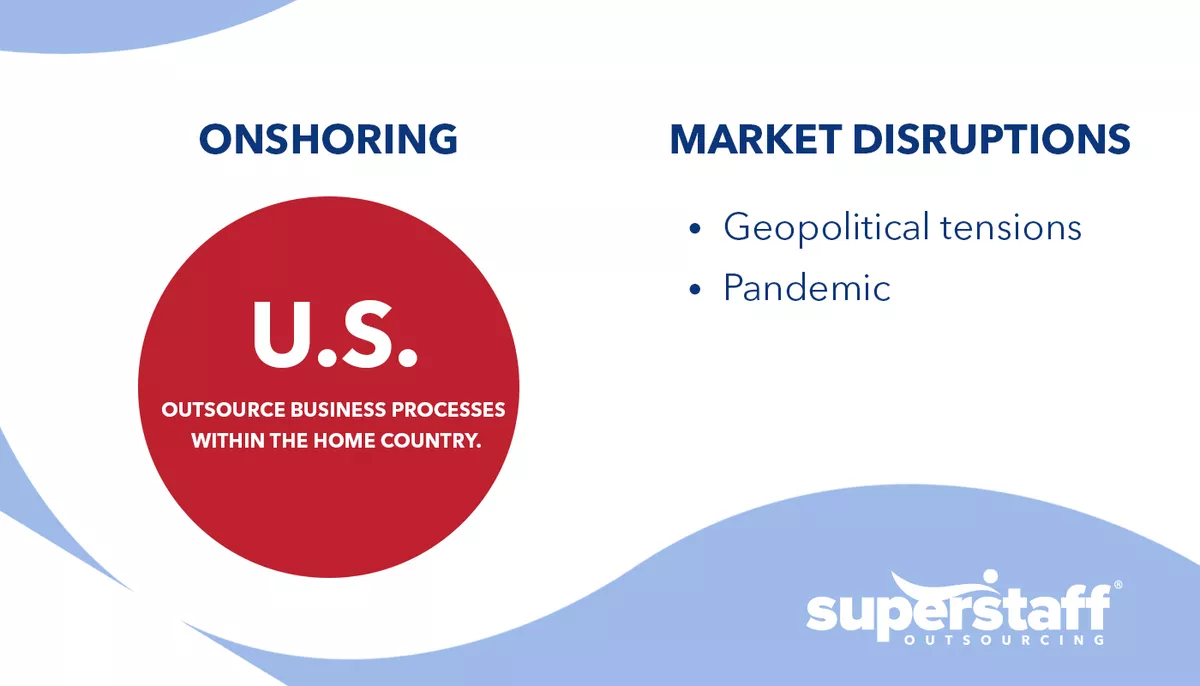
Onshoring, also called onshore outsourcing, is when companies delegate a part or all of their processes to an outsourced team within their home country. The main difference between domestic offshoring and onshoring is that the former only encompasses customer service and tech roles, while the latter can involve a wide range of functions, from digital jobs to blue-collar labor.
One example of onshoring is when a small business outsources office cleaning duties, garbage removal, and building maintenance to a local cleaning agency with highly trained and experienced custodians.
Another example is a New York consumer electronics company delegating technical support and help desk roles to a call center in Pennsylvania.
What Are the Factors Shaping Onshoring?
Financial and Tax-Related Considerations
One of the main reasons businesses embrace onshoring is the many financial and tax incentives associated with keeping your workforce within the country. In 2022, the U.S. government introduced policies incentivizing companies to prioritize onshore labor, especially for manufacturing and distribution jobs.
The policies proposed include initiatives for financing local manufacturing businesses through the Export-Import Bank (EXIM) and investing in sustainable domestic production processes.
Logistics Concerns
Logistics is another factor influencing many companies’ decision to outsource onshore. The further your production line is from your target consumers, the more you spend on shipping and transportation costs.
At the same time, you’ll have to contend with longer lead times, navigate complex delivery logistics, and deal with complicated cross-border policies. Onshoring can help you avoid these challenges while reducing transportation and delivery costs.
Reshoring
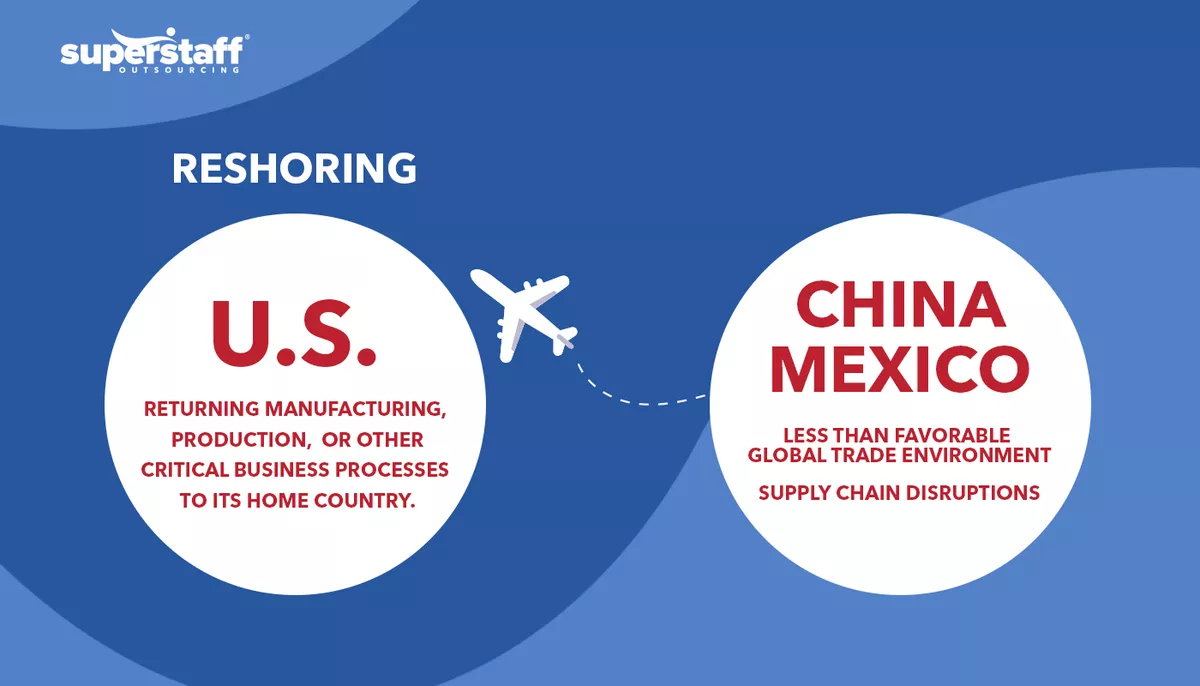
Reshoring refers to returning a company’s manufacturing, production, or other critical business processes to its home country.
Much like onshoring and domestic offshoring, reshoring involves prioritizing the labor force within your nation’s borders. The difference between these terms is that reshoring is focused on bringing operations back from a foreign country.
Businesses utilizing onshore and domestic offshoring operations may have never outsourced to faraway countries in the first place, opting to keep all processes within their borders.
One example of reshoring is how some U.S. companies previously outsourced their factory work to countries like China or Mexico. However, they decided to build factories within their nation due to specific practical considerations.
What Are the Factors Shaping Reshoring?
Supply Chain Disruptions
Many U.S. companies have adopted reshoring strategies because of ongoing supply chain disruptions. The global trade environment has been less than ideal in recent years, leading to numerous shipping delays, scarcity of needed raw materials and components, cross-border restrictions, steep tariff hikes, and, ultimately, empty stock shelves and unhappy customers.
To address supply chain gaps, reshoring has emerged as a top strategic option for many companies, particularly manufacturers. According to a 2023 Q1 report from the Reshoring Initiative, the number of businesses opting to reshore their operations has increased by 11% compared to the previous year.
Companies are bringing an estimated 101,500 manufacturing jobs back home to improve their sustainability. Industry experts say that if reshoring programs continue at their current pace, about 400,000 jobs will be returned to the U.S.
These findings echo another report from the Kearney Annual Reshoring Index, which found that most American CEOs (96%) see reshoring as a critical strategy for supply chain resilience, with most already beginning their reshoring initiatives this year.
Geopolitical Tensions
The unstable international trade environment is another factor affecting business leaders’ decisions to reshore their processes. Geopolitical tensions within a country can create unforeseen problems for U.S. companies that have established a part of their supply chain operations overseas.
Here’s one key example of how geopolitical tensions impact international trade: Historically, the U.S. sourced 30% of platinum, 13% of titanium, and 11% of nickel from Russia. These raw materials are crucial components of several products, including automobiles, batteries, and electronics.
Due to the War in Ukraine, manufacturers could no longer import these raw materials, disrupting the production of many industrial products.
Offshoring
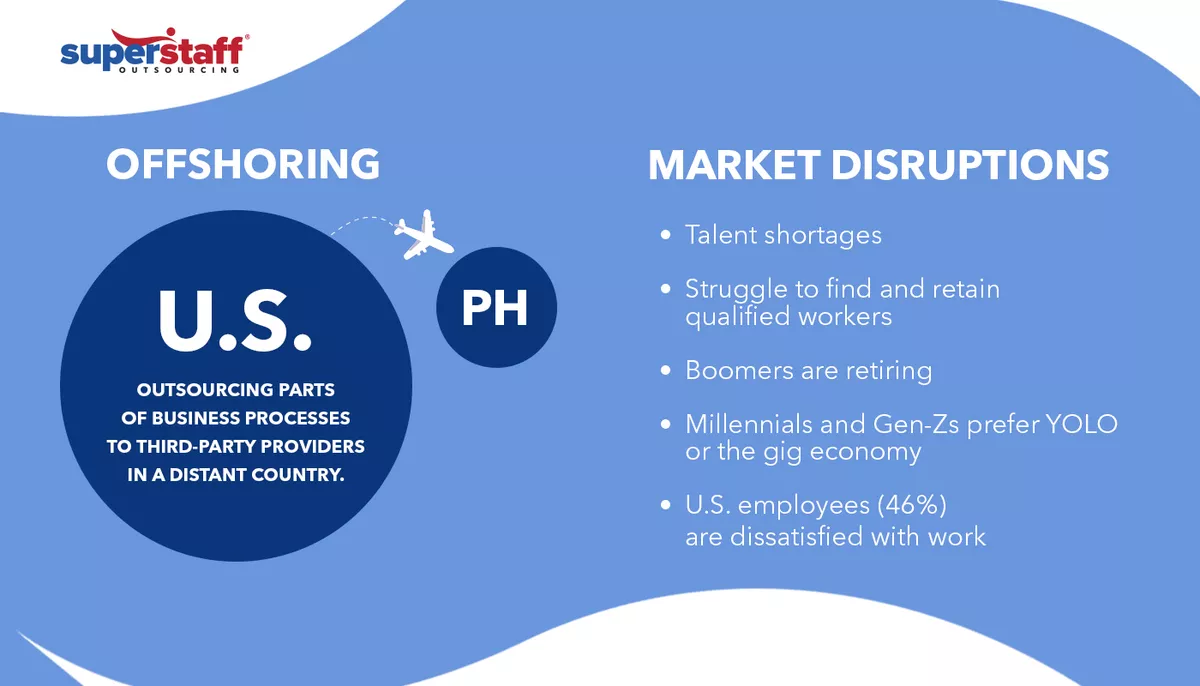
What Are the Factors Shaping Offshoring?
Western Talent Shortages Due to Aging Populations
Despite the global labor market showing greater stability, talent shortages are expected to persist throughout 2023 and beyond. Labor participation rates have bounced back from the ripple effects of the COVID-19 pandemic, but turnover rates remain sky-high.
Although businesses worldwide are navigating talent shortages, Western economies, in particular, are struggling to find and retain qualified workers. According to industry experts, this is happening because developed countries have many employees from the massive Baby Boomer generation, many of whom are retiring.
As Boomers retire, the Millennials and Gen-Zs are expected to take over most of the labor force. However, these two generations have different expectations and preferences for their ideal careers.
Many have even turned away from traditional employment and ran toward the so-called “YOLO economy,” resulting in a wealth of unfilled job openings in the Western labor market.
The opportunities left behind by these younger generations of Western workers opened the doors for offshore teams. Now, in an attempt to fill the gaps in their workforce, many U.S. companies invest in offshore outsourcing projects, particularly in countries like the Philippines, where there is a large population of willing workers.
Americans’ General Perception of Routinary Tasks
Even as “The Great Resignation” slows down, today’s American workers continue expressing dissatisfaction with work.
A recent survey found that almost half of U.S. employees (46%) say they wouldn’t recommend their job to their children or anyone they care about. Even worse, 4 out of 10 say they wouldn’t wish for their worst enemy to take on their role.
Why do American employees feel dissatisfied with their jobs? For many workers, boredom with their daily routine tasks is a huge factor. Though relatively simple, these tasks can add to their core workload, making them feel more stressed and overwhelmed, eventually leading to burnout if left unaddressed.
Thankfully, one of the effects of offshoring is being able to lighten the workload of U.S. teams. By delegating administrative and support tasks to a remote team, workers can concentrate on doing what they do best and avoid mental stress.
Offshoring to the Philippines
Although many strong contenders for offshore BPO locations exist, the Philippines remains a favorite outsourcing destination for many U.S. companies. Here are some of the reasons why:
Cost Reduction
When deciding between offshoring and outsourcing solutions closer to home, the leading competitive edge offered by the former is significant cost savings.
To illustrate: the average salary for a customer service representative in the U.S. is $37,271 (as of May 2023). Meanwhile, the average salary for the same role in the Philippines is P20,314 or $360.87.
Massive Population of Skilled Talents
With Western markets having a limited pool of workers, offshoring to the Philippines can help companies significantly expand their talent pipelines. According to the latest United Nations data, the Southeast Asian nation currently has an estimated population of 113,815,695, and a significant portion includes willing and able workers.
U.S. companies can tap into this large labor force and strengthen their in-house team with a global back-office support provider that helps them pull all aspects of their operations toward maximum productivity and efficiency.
Affinity for Western Culture
Filipinos are very attuned to Western culture because the U.S. and the Philippines share a colonial history, including American consumers’ preferences, communication styles, and language. Filipinos are also known for being hard-working and empathetic, making them ideal customer service workers for many U.S. businesses.
Nearshoring
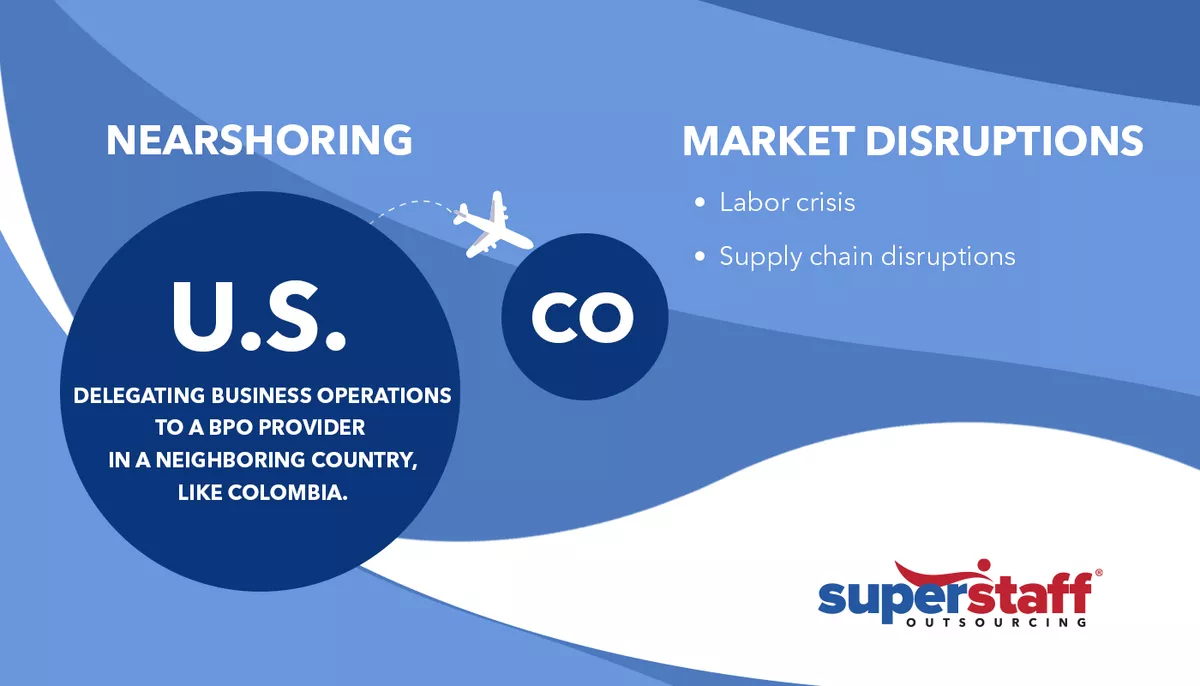
Nearshoring means delegating parts or all of your business operations to a BPO provider in a neighboring country. For instance, many U.S. businesses outsource critical functions to their partner companies in the Latin American region.
What Are the Factors Shaping Nearshoring?
Need for Greater Supply Chain Control
Before COVID-19, many American manufacturers partnered with offshore providers from distant locations like China. However, at the height of the global pandemic, these businesses quickly realized the problem with keeping their production far away from their home base and target consumers.
One example is Premium Guard Inc, an automotive supply company that once relied on Chinese factories for its necessary materials and components. In 2020, surging shipping costs, global shipping container shortages, and souring U.S.-China relations brought their supply chain to its knees.
Premium Guard began setting up nearshore factories in Mexico to address these logistics hurdles and exert greater control over their supply chain. As such, they were able to diversify their sourcing strategy and are no longer reliant on a single country for their production.
Continued Tech Talent Shortages
Due to the severe global talent shortage, experts predict that over 85 million jobs will remain unfilled by 2030. American companies, in particular, feel the effects of this labor crunch, with over 75% of U.S. businesses lamenting their difficulty finding and securing qualified talents.
Outsourcing to Latin American BPOs can help reduce the effects of the Western labor crisis, particularly for tech companies and other sectors needing IT and software development professionals.
Nearshoring to Colombia
If you’re searching for your ideal nearshoring location, Colombia may present a wealth of opportunities for your business. Here’s why:
Stable Economic Conditions
Colombia boasts one of South America’s most robust, fastest-growing, and stable economies. Unlike other countries whose economies plummeted significantly during COVID-19 and struggled to bounce back, Colombia’s economy grew 5.5% in 2022. This year, its economy grew another 3.1%.
Thanks to the country’s robust technological infrastructure, they were able to thrive amid the lockdown and quarantine periods. Even today, the Colombian government continues to invest in digital transformation to help accelerate business expansion and support foreign investors who wish to outsource to the country.
Close Proximity to the United States
When outsourcing to Colombia, U.S. businesses won’t have to worry about finding the perfect time to meet with their nearshore partner. Because the Colombian time zone is closely aligned with the U.S., you can easily connect and collaborate with your BPO provider.
At the same time, if your goal for nearshoring is to keep your supply chain closer to home, Colombia’s geographic proximity offers a distinct advantage. If you want to examine or observe your nearshore operations closely, you could simply hop onto a quick 4 to 6-hour flight and visit the site without hassle.
How to Choose Between Different Outsourcing Models
Now that we’ve taken a comparative look at the outsourcing options available to U.S. businesses, you may wonder, “How can I choose between them? Which solution is right for my company?”
The truth is that there is no such thing as a one-size-fits-all outsourcing solution. The strategy that will work best for you will depend on several factors, including your existing business model, your particular industry, the challenges and problems you hope to address, and the opportunities you seek.
Select the Solution That Works for Your Particular Business
Let’s say you’re a consumer electronics manufacturer, and your most significant hurdle right now is controlling your supply chain. Nearshoring could be a great strategic option because it’ll allow you to keep your operations closer to home while taking advantage of the lower labor costs in nearby countries.
If you can afford to be more hands-off in your approach (let’s say you’re an e-commerce brand needing qualified customer service reps), offshoring can be the best way. Since your CS team lives in an entirely different time zone, they can answer customer calls and messages past your regular business hours.
A hybrid outsourcing strategy can do the trick for businesses looking to improve their flexibility while maintaining operational resilience. Blending onshore, nearshore, and offshore solutions help you avoid being dependent on only one location (which helps reduce risk and diversifies your sourcing activities) while also future-proofing your operations in case another significant disruption occurs.
Fortify Your Business in the Age of Market Disruptions
Supply chain troubles, rising inflation, looming U.S. debt, and other market disruptions are still on the horizon for 2023 and beyond. But that doesn’t mean you can do nothing to safeguard your operations and expand your business.
Whether you opt for domestic offshoring, onshoring, offshoring, nearshoring, or a combination of strategies, working with the right outsourcing partner can prepare your company for the future and keep your processes running smoothly even in the Age of Disruption.
Here at SuperStaff, we are passionate about helping businesses do just that. Our comprehensive and scalable outsourcing solutions empower brands to take charge of their processes, streamline and optimize their workflows, and improve their key metrics while saving on costs.
Reach out to us today, and let’s talk about what our BPO solutions can do for you!






